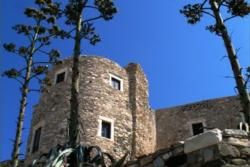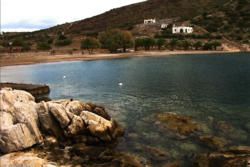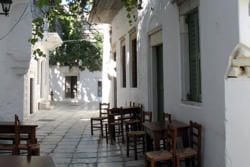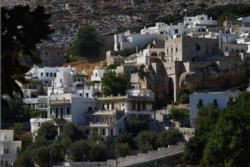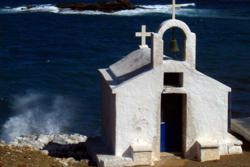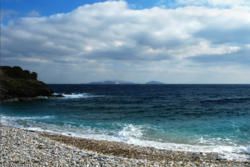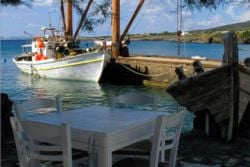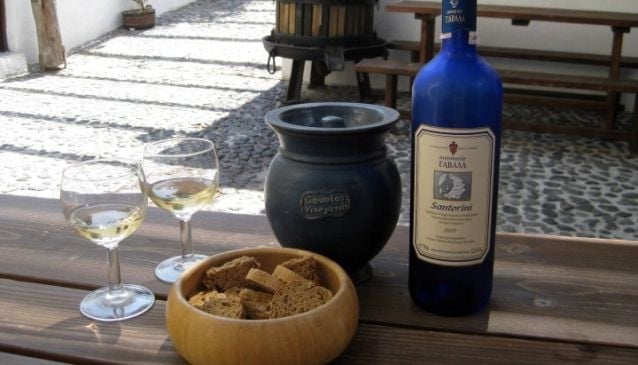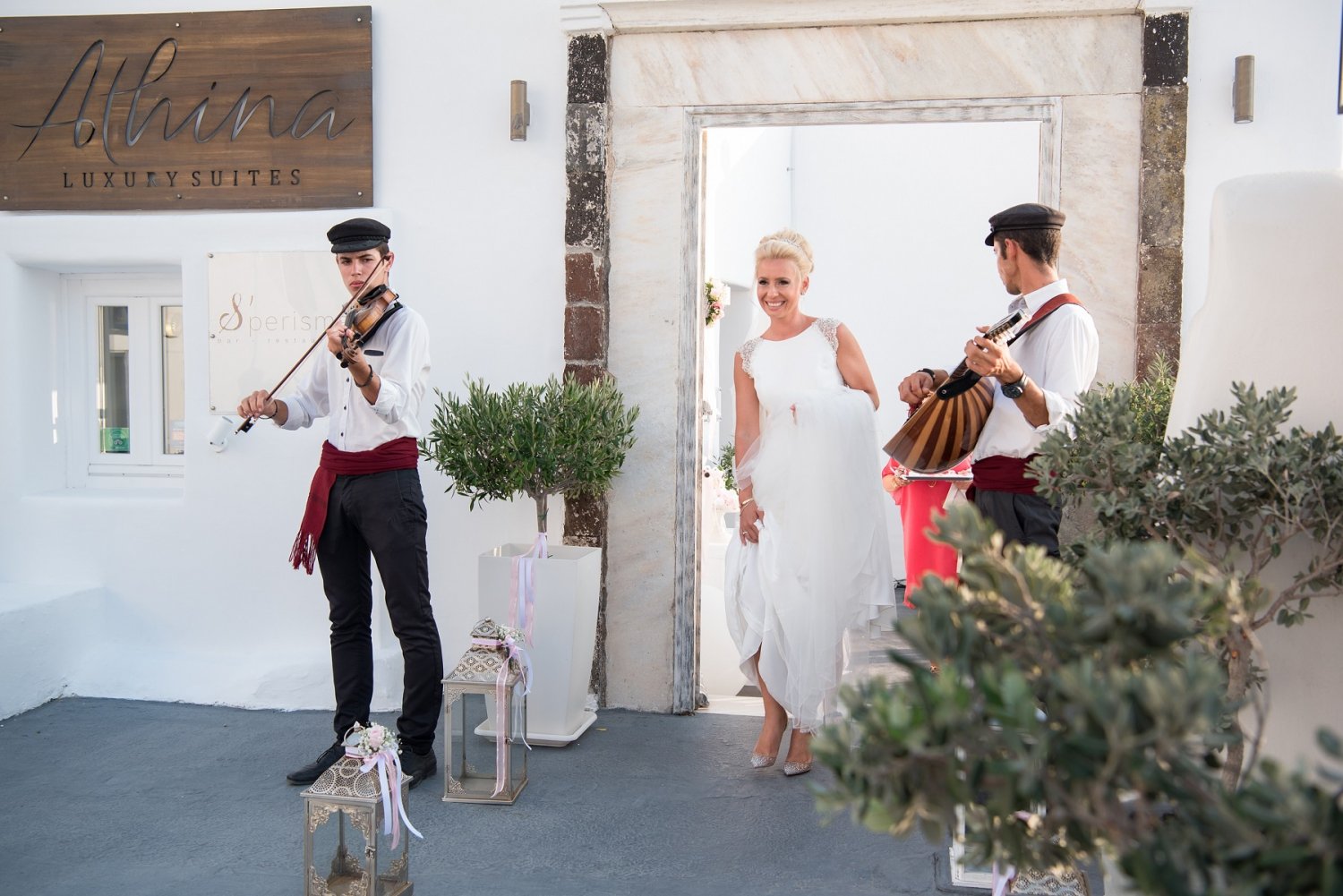Naxos
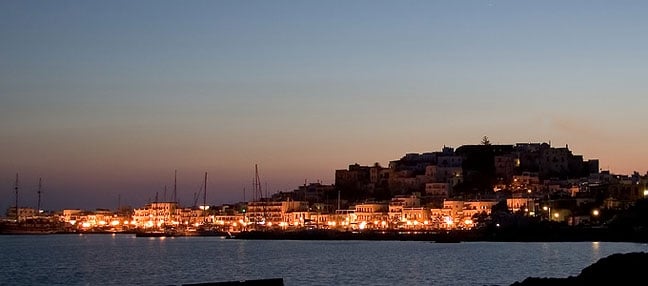
The islandâs view as the ship approaches is drawn heavily from its mountains. But as it comes closer and closer, the soft coloured tones of the lovely postcard of Hora is popping, where endless beaches embrace the dream and the fantasy fades away through the oleanders that are flooding the valleys of Naxos.
You canât miss the port of Naxos. Upon entering, the islet of Palatia becomes the most welcoming setting. It is mostly known for the impressive marble gate (part of a 6th century BC temple for the god Apollo) the sublime "Portara", as it is called by the locals. According to mythology, Naxos was the island where Dionysus, the god of wine used to live, and when Ariadni was abandoned by Thesseus on that islet, they met and got married.
Naxos is found in the heart of Cyclades, in the heart of Aegean. Has always followed the destiny of adventure of its residents. This destiny is interwoven with travel, exchanges, new techniques and pioneering ideas, but also with wars and conflicts over the hegemony of sea. It is the biggest and the greenest island among Cyclades with impressively high mountains, fertile valleys, lush green gorges, stunning seascapes and traditional villages perched high on mountain tops, where the inhabitants still wear their traditional dress and live off the fruits of the land. Naxos is also an island of beautiful old churches, monasteries and Venetian castles coexisting harmoniously with Cycladic cubic houses.
Stepping on the island, you face its capital, where the mild tourist development is a welcoming surprise. Horaâs landmark is an imposing Venetian castle, is an old castle town with stone paved alleys (kalderimia) where you can admire a unique blend of Cycladic and Medieval architecture: mansions with Venetian blazons still decorating their entrances, narrow alleys with arches ("stegadia"), catholic churches and fortifications.
What impresses from the first moment is the temperament of the inhabitants. It is their extroversion (something that is easily proved by the celebrations and customs), and their song and poetry.
The Venetian castle (called "Kastro") is undoubtedly the most enchanting part of Hora. Built on a hilltop, the castle offers a spectacular view to the Aegean Sea, particularly at sunset, when the coasts of Paros become visible. Passing through the main gate ("Trani Porta") you can admire the tower with its battlements, which are kept in their original position. Interest is also found at the houses inside the castle, many of which are dated since the 14th and 15th century, and their facades still have the built-in Venetian blazons.
In the castle you will also see the Venetian church, the building of the School of Nuns (Ursulines), the metropolis of the Roman Catholic Church and the residence of the Catholic bishop. Finally, the Belonia Tower -6 km from the capital- on the road heading to nearby village of Galanado, used to be the residence of the Venetian ruler of the region. Also interesting, the Crispi-Glezos Tower and Della Rocca- Barozzi Tower (Hora),
An interesting visit is also the Archaeological Museum, housed in a historic building of the Venetian Period, housing finds from the Early Neolithic Age up to the Early Christian (Paleochristian) Period and an interesting collection of Cycladic figurines.
The landscape of Naxos has many rotations. Plains succeed barren areas, marble mountains lead in deep shadowed glens, areas with vegetation host all-white villages and sandy beaches meet the sea.
The coastline of the island is almost straight and not forming large natural harbours, which affected the occupations of residents from the ancient years. In the island from end to end beautiful and clean coasts are situated next to small solitary coves. The ground of island is blessed and provides self-sufficiency to the life of this place. The rich aquifer of Naxos offers drinking water to wells and streams of the island. The fertile land produces citrus fruits, olives, fruits, vegetables, potatoes (Naxos' speciality) and amazing wine. Livestock-farming and the apiculture are particularly developed and offer exceptional quality meats, milk, cheeses and thyme honey.
The mainland holds many secrets and surprises. It is worth taking your car to Naxos (or rent one for your stay). Explore the inland villages; discover their castle-houses, the tiny Chapels and the magnificent signs of the past, reminders of the civilisations and archaeological finds.
Explore the varied geomorphology and biodiversity of the island by following breathtaking routes all around the island (HoraâMelane-Halki, HalkiâDanakos-Apeiranthos, Skado-Apollonas, etc.); follow the hiking trail from Apeiranthos to Moutsouna beach along the emery mines (12 km) and the breathtaking view to the Archipelago (all the way) will make it up to you. Climb to the top of Zas Mountain, Cycladesâ highest mountain (1,004 m) or follow beautiful biking routes around the mountains. On your way to Zasâ top, donât forget to visit the beautiful cave of Zas, which used to be dedicated to god Zeus and observe its impressive stalactite formations.
At Halki, apart from beautiful neoclassical houses, you will find the traditional Winery of Valindras, that produces the famous liqueur âKitronâ of Naxos (like Limoncino) since 1896.
Visit traditional villages spread around the island, with a particular, "magical" character: Aperathos is a colourful mountainous village boasting five museums, stone-built houses, beautiful squares and narrow alleys paved with marble and Panagia Drosiani, a beautiful church of the Early Christian Period! Filoti, built on the top of a rock, is a picturesque mountainous village surrounded by lush vegetation with cubic shaped houses and narrow stone-paved alleys. The community of Sagri consists of five small villages (Ano Sagri, Kato Sagri, Kanakari, Kastraki and Mikri Vigla). You will feel admiration before the Venetian towers, the traditional windmills and a number of major Byzantine churches.
Naxos used to be the seat of the Ducat of the Aegean; explore a great number of well preserved towers like the Bazeos Tower in Sagri and the the Belonia Tower at Galanado. Being the most fertile island of Cyclades, Naxos boasts a major agricultural production. Taste quality local products, like olive oil, potatoes, spoon sweets, mouth watering wine and above all the renowned cheeses of Naxos: graviera (hard cheese), xinomyzithra (made of goat or sheep milk, yeast, and salt), xinotyro (sour cheese), arseniko (a tasty hard cheese made of goat and sheep milk) are culinary pleasures guaranteed to satisfy your palate.
Mostly visited, some of the well known beaches of the island are located on the west side, like Agios Prokopios. Only 5 km from Hora, you will find a beach of 2 km long covered with fine white sand shapes to a row of small sand dunes; it is the third best beach in Greece and is concerned as one of the ten best beaches in Europe. It is a popular destination for lots of visitors. The colour of its crystal clear waters goes from blue to turquoise, blue/azure to aquamarine. A true feast of colours.
Just a few kilometres away, I would suggest the beach of Plaka, being a natural extension of Agia Anna beach. Endless fine sand with big sand dunes is laved by the blue, beautiful Aegean Sea. Heading south, you will see the bay of Mikri Vigla; is one of the most beautiful coasts of Naxos and because of the perfect windy weather conditions, an ideal destination for surfers. Two are the best beaches: "Parthenos", in the north side and "Sahara" in the south side, separated by a rocky shred of ground.
If the road has taken you close to Apeiranthos and the emery mines of the area, it is a nice opportunity to see the eastern beaches, like Moutsouna, Azalas, and Psili Ammos, a wonderful sandy beach with blue waters. Psili Ammos differs from the other beaches of the island, because of the big trees at the sand dunes that add an exotic colour to it. This dreamy landscape is between Moutsouna and Panormos.
Naxos is also famous for its wide variety of cultural events and traditional fairs that you can enjoy watching during your stay. Donât miss the Naxos Festival, organised by the Municipality of Naxos at Bazeos Tower and "Dionissia". It includes various fascinating events taking place all summer long. The celebrations culminate with the famous "Wine Festival" and the "Fishermanâs Feast" held in September.
- Naxos is connected by ferry to Piraeus, Rafina, Lavrio and the rest of the Cyclades.
- You can also reach it by aeroplane from Athens and Thessaloniki
| SERVICE | PHONE NUMBER |
| Municipality | +30 22853-60100 |
| Airport | 22850-23292 |
| Police | 22850-22100 |
| Port Police | 22850-22300 |
| Medical centre | 22850-23333 |
| Fire Station | 22850-32199 |
| Post Office | 22850-22211 |




